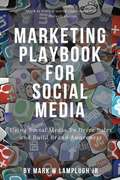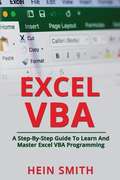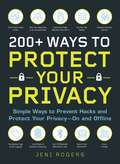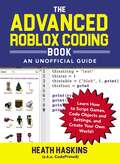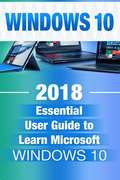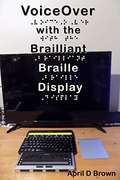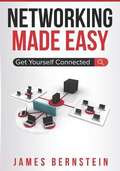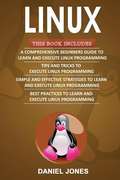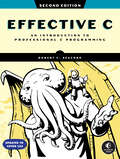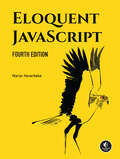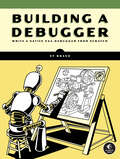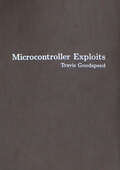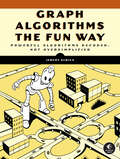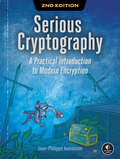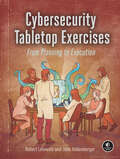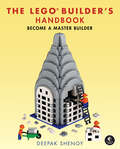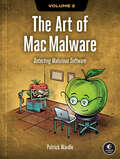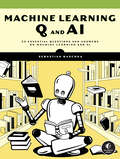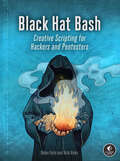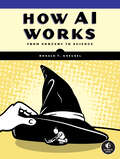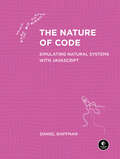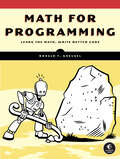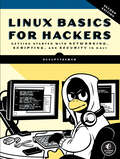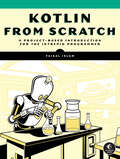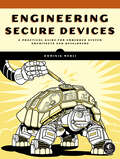- Table View
- List View
Marketing Playbook for Social Media: Using Social Media to Drive Sales and Brand Awareness
by Mark W LamplughThe information in this book will help you to create and grow a strong social media presence for your business that will allow you to obtain the all the potential that social media has to offer. Social Media is being highly adopted by the wider population therefore it is imperative to deliver the right message to the right platform.
Excel VBA: A Step-By-Step Guide to Learn and Master Excel VBA Programming
by Hein SmithWhether you have never created a program with Visual Basic Application or looking to learn some new tricks, then this book is for you! Containing 15 chapters full of information, definitions, and step-by-step instructions to create your own programs, this book will help you master VBA Programming. Here are just a few of the things you will find inside: Chapters on Conditional Logic, String Functions, and Recording Macros Images illustrating the different processes and programming steps Step-by-step instructions for how to program Loops and Arrays 2 chapters on creating and programming User Forms Instructions on how to write Subs and Functions Written out sample codes for many of the programs you will learn how to create How to diagnose and correct your own coding errors A step-by-step process on how to connect the Visual Basic Editor with external dataVisual Basic Application Programming in Excel is a hidden gem that will help you automate and control both basic and complex Excel functions. Following the steps in this book will help you access the inner workings of Excel spreadsheets and take your coding to the next level!
200+ Ways to Protect Your Privacy: Simple Ways to Prevent Hacks and Protect Your Privacy--On and Offline
by Jeni RogersDiscover simple strategies for protecting your personal and confidential information on and offline with this essential and easy-to-understand guide. We all know that the internet can serve as a hotbed for identity theft. But it isn’t the only place where your privacy can be breached. In fact, there are lots of ways you can protect your privacy (or diminish it) that have little or nothing to do with access to the internet. Your home, your photos, your trash can, your kids, your favorite restaurant or store—and even you have the ability to unknowingly reveal your private information to everyone from thieves to busybodies. But you don’t need to hire a specialist to keep your information safe—you can do it yourself with these 200+ easy-to-implement tactics, some of which include: —Shredding hard copies of bills — Turning off Bluetooth when not in use — Using a firewall — Hiding spare keys in an unusual place Keeping your information secure lies in your hands—make sure you’re not putting yourself at risk in your daily habits with this essential guide.
The Advanced Roblox Coding Book: Learn How to Script Games, Code Objects and Settings, and Create Your Own World! (Unofficial Roblox)
by Heath HaskinsClear and easy-to follow instructions for using coding and scripting tools to create new, more advanced Roblox games.Take your game design to the next level, with this complete guide to Roblox coding and scripting! Learn how to code using the programing language Lua to create new objects and games in the Roblox world: from teleporting objects (or PCs/NPCs!), to adding and applying power ups, to creating a leaderboard, and allowing players to save their games. This book walks you through the basics of the studio tool, provides tutorials for specific actions and creations, then explains how to use all of that knowledge to create your own unique game world! With detailed instructions, example screenshots, and simple explanations of what code to use and how to use it, this book is a must-have guide for any Roblox game designer—from beginners to expert coders!
Windows 10: 2018 Essential User Guide to Learn Microsoft Windows 10
by Alexa Wallace<p>Welcome to the ultimate Windows 10 beginners guide with simple, faster, and proved guidelines that make sure you get the most out of the Windows 10 PC. Windows 10 refers to Microsoft operating system meant for personal laptops, phones, embedded devices and internet of the devices. One primary reason why you need to upgrade to Windows 10 is the fact that the upgrade is unrestricted because you can upgrade to Windows 10 without making any payments for a full Windows 10 version. <p>This book will cover the following topics: <p> <li>A general overview of Windows 10 <li>Innovative features <li>Windows 10 Apps <li>Useful tips and tricks on Windows 10 <li>How to back up and restore files on Windows 10 <li>Internet connectivity</li> <p> <p>The book is a perfect guide because a clear outline of tips and tricks such as Night Light feature, Change to Tablet Mode, Changing the default browser, dark theme usage among others. The tips enable the user to grasp a deeper understanding of Windows 10. When it comes to files back up and restoration, the book has every single step to ensure the safety of the files and relevant information. </p>
VoiceOver with the Brailliant Display
by April D BrownLearn what a screen reader can, and cannot do. Build a step by step foundation to screen reader use with the Brailliant braille display to read, write, work, and communicate using VoiceOver on the Mac. <P><P>Familiarize unfamiliar screen reader terms in order to develop and expand knowledge. Translate spoken VoiceOver commands to braille display commands. Learn to use a computer as easily as before sight and hearing loss. <P><P>Originally published in June 2016 - VoiceOver with a Mac Mini using operating system El Capitan and a Brailliant Braille Display. Last updated for Sierra, OSX fall of 2016.
Networking Made Easy: Get Yourself Connected (Computers Made Easy)
by James BernsteinNetworking Made Easy is designed to take your overall networking skills from a beginner to the next level. Get a top-level understanding without a complex education. This easy to use guide will help you navigate your way to becoming proficient with network fundamentals and technology.
Linux: A Comprehensive Beginners Guide to Learn and Execute Linux Programming
by Daniel JonesIf you want to learn Linux programming, there’s not a better book on the market for you. This Powerful pack of 4 books is going to assume you know absolutely nothing about Linux, then teach you everything from A-Z, some of the most significant topics that will be covered in this book are as follows: The most common and useful Linux command line tools How to write Bash scripts and automate your command line workflow How to program in C++ and Python How to understand and think about high-level programming concepts in order to become a better programmer in the end The differences between functional and object-oriented programming and how they apply to you You may be absolutely stumped and not know where to look. However, this book will teach you everything you need to know - and fast! Without mincing words, the book teaches you two programming languages, how to write scripts, and how to navigate the Linux command line very well. So what are you waiting for? Pick up a copy of this 4 Books bundle now and get to programming on Linux like a master!
Effective C, 2nd Edition: An Introduction to Professional C Programming
by Robert C. SeacordEffective C, 2nd edition, is an introduction to essential C language programming that will soon have you writing programs, solving problems, and building working systems.The latest release of the C programming language, C23, enhances the safety, security, and usability of the language. This second edition of Effective C has been thoroughly updated to cover C23, offering a modern introduction to C that will teach you best practices for writing professional, effective, and secure programs that solve real-world problems.Effective C is a true product of the C community. Robert C. Seacord, a long-standing member of the C standards committee with over 40 years of programming experience, developed the book in collaboration with other C experts, such as Clang&’s lead maintainer Aaron Ballman and C project editor JeanHeyd Meneide. Thanks to the efforts of this expert group, you&’ll learn how to: Develop professional C code that is fast, robust, and secureUse objects, functions, and types effectivelySafely and correctly use integers and floating-point typesManage dynamic memory allocation Use strings and character types efficientlyPerform I/O operations using C standard streams and POSIX file descriptors Make effective use of C&’s preprocessorDebug, test, and analyze C programs The world runs on code written in C. Effective C will show you how to get the most out of the language and build robust programs that stand the test of time.New to this edition: This edition has been extensively rewritten to align with modern C23 programming practices and leverage the latest C23 features.Updated to cover C23
Eloquent JavaScript, 4th Edition
by Marijn HaverbekeStart building beautiful web applications in JavaScript with the bestselling introduction to the language, updated with new features, fresh exercises, and fun projects.JavaScript, the programming language that allows us to add programs to web pages, lies at the heart of almost every modern web application, from social media sites to browser-based games. Just about every device can run it, making it a great choice for writing universally useful code.The fourth edition of this classic textbook takes you on a journey through the language of the web, starting from its basic elements and building up to engaging, complete programs. The author&’s personal experiences from years of maintaining popular open source projects enliven the text with practical insights and examples. This edition of Eloquent JavaScript updates the book to describe the 2024 version of JavaScript, and shifts the attention given to some topics to better reflect current development practices.The text takes a practical approach to teaching, rooting theory in plenty of motivating examples. The first half of the book describes the fundamentals of the language, whereas the second half shows how to apply it in two programming environments: the web browser and Node.js. Five project chapters show how to build bigger programs, working through these projects in a piecemeal, conversational way. They include a pathfinding robot, a small programming language, a platform game, a pixel drawing program, and a simple dynamic website.Exercises provided at the end of most chapters will challenge you to creatively apply the concepts and techniques introduced. The book&’s companion website provides an interactive environment for working on these exercises and playing with the example programs.Whether you&’re looking to learn JavaScript or to deepen your programming skills, you&’ll find this book full of stimulating material.Updated to ECMAScript 2024
Building a Debugger: Write a Native x64 Debugger From Scratch
by Sy BrandMaster the inner workings of your x64 Linux system and expand your OS expertise by writing your very own debugger using C++.If debuggers seem like magic to you, there is no better way to demystify them than to write your own. This book will show you exactly how to do it, walking you through the entire process of building a debugger for x64 Linux systems using C++. As go from an empty filesystem folder to a fully fledged debugger capable of setting breakpoints, stepping through code, manipulating variables, and more, you&’ll learn how to:Attach to a processRead and write to registersSet hardware and software breakpointsOutput disassemblySupport multithreading and other tasksAs you add features to your debugger, you&’ll also pick up a wealth of knowledge about operating systems, compilers, software testing, and low-level programming that you can use in your day-to-day development.
Microcontroller Exploits
by Travis GoodspeedMicrocontroller Exploits is a deep dive into advanced hardware hacking with detailed examples of real-world techniques and a comprehensive survey of vulnerabilities.In this advanced guide to hardware hacking, you'll learn how to read the software out of single chip computers, especially when they are configured not to allow the firmware to be extracted. This book documents a very wide variety of microchip hacking techniques; it's not a beginner's first introduction.You'll start off by exploring detailed techniques for hacking real-world chips, such as how the STM32F0 allows for one word to be dumped after every reset. You'll see how the STM32F1&’s exception handling can slowly leak the firmware out over an hour, and how the Texas Instruments MSP430 firmware can be extracted by a camera flash.For each exploit, you'll learn how to reproduce the results, dumping a chip in your own lab.In the second half of the book you'll find an encyclopedic survey of vulnerabilities, indexed and cross referenced for use in practicing hardware security.
Graph Algorithms the Fun Way: Powerful Algorithms Decoded, Not Oversimplified
by Jeremy KubicaEnter the wonderful world of graph algorithms, where you&’ll learn when and how to apply these highly useful data structures to solve a wide range of fascinating (and fantastical) computational problems.Graph Algorithms the Fun Way offers a refreshing approach to complex concepts by blending humor, imaginative examples, and practical Python implementations to reveal the power and versatility of graph based problem-solving in the real world. Through clear diagrams, engaging examples, and Python code, you&’ll build a solid foundation for addressing graph problems in your own projects.Explore a rich landscape of cleverly constructed scenarios where:Hedge mazes illuminate depth-first searchUrban explorations demonstrate breadth-first searchIntricate labyrinths reveal bridges and articulation pointsStrategic planning illustrates bipartite matchingFrom fundamental graph structures to advanced topics, you will:Implement powerful algorithms, including Dijkstra&’s, A*, and Floyd-WarshallTackle puzzles and optimize pathfinding with newfound confidenceUncover real-world applications in social networks and transportation systemsDevelop robust intuition for when and why to apply specific graph techniquesDelve into topological sorting, minimum spanning trees, strongly connected components, and random walks. Confront challenges like graph coloring and the traveling salesperson problem.Prepare to view the world through the lens of graphs—where connections reveal insights and algorithms unlock new possibilities.
Serious Cryptography, 2nd Edition: A Practical Introduction to Modern Encryption
by Jean-Philippe AumassonCrypto can be cryptic. Serious Cryptography, 2nd Edition arms you with the tools you need to pave the way to understanding modern crypto.This thoroughly revised and updated edition of the bestselling introduction to modern cryptography breaks down fundamental mathematical concepts without shying away from meaty discussions of how they work. In this practical guide, you&’ll gain immeasurable insight into topics like authenticated encryption, secure randomness, hash functions, block ciphers, and public-key techniques such as RSA and elliptic curve cryptography.You&’ll find coverage of topics like:The basics of computational security, attacker models, and forward secrecyThe strengths and limitations of the TLS protocol behind HTTPS secure websitesQuantum computation and post-quantum cryptographyHow algorithms like AES, ECDSA, Ed25519, Salsa20, and SHA-3 workAdvanced techniques like multisignatures, threshold signing, and zero-knowledge proofsEach chapter includes a discussion of common implementation mistakes using real-world examples and details what could go wrong and how to avoid these pitfalls. And, true to form, you&’ll get just enough math to show you how the algorithms work so that you can understand what makes a particular solution effective—and how they break. NEW TO THIS EDITION: This second edition has been thoroughly updated to reflect the latest developments in cryptography. You&’ll also find a completely new chapter covering the cryptographic protocols in cryptocurrency and blockchain systems.Whether you&’re a seasoned practitioner or a beginner looking to dive into the field, Serious Cryptography will demystify this often intimidating topic. You&’ll grow to understand modern encryption and its applications so that you can make better decisions about what to implement, when, and how.
Cybersecurity Tabletop Exercises: From Planning to Execution
by Robert Lelewski John HollenbergerThe complete start-to-finish guide for planning and delivering successful cybersecurity tabletop exercises.Cybersecurity Tabletop Exercises, written by veteran security consultants Robert Lelewski and John Hollenberger, is an essential resource for cybersecurity professionals and anyone tasked with enhancing their organization&’s incident response capabilities. This comprehensive guide to tabletop exercise planning and delivery offers practical insights, step-by-step instructions, and real-world examples to improve your team&’s ability to prevent and respond to cyberattacks.The book is divided into two main parts. In Part I: The Tabletop Exercise Process, you&’ll learn:Why you should perform tabletop exercises and what their organizational benefits are Effective planning and logistics tips, including how to gain executive sponsor supportHow to develop realistic scenarios, injects, and storyboardsFacilitation techniques to ensure active participant engagementEvaluation methods and follow-up activitiesThe example scenarios in Part II include:Technical tabletops covering phishing campaigns, ransomware attacks, and zero-day vulnerabilitiesExecutive-level exercises that focus on high-impact incidentsCross-functional cases such as physical security breaches, social media compromises, and insider threatsWith examples tailored for various roles, you&’ll discover how to transform tabletop exercises from a mere compliance requirement into a powerful strategic preparedness tool. Whether you&’re new to tabletop exercises or an experienced practitioner, this book provides proven insights to strengthen your organization&’s cyber incident response capabilities and overall security posture.
The LEGO Builder's Handbook: Become a Master Builder
by Deepak ShenoyForget step-by-step instructions — you&’re ready to design your own LEGO creations! The LEGO Builder&’s Handbook is the only guide you need for building totally out-of-this-world, wholly original models.What&’s the right scale to use for your LEGO model? How does SNOT, also known as sideways building, work? What&’s the trick to achieving smoother tapers? How do you design a LEGO sculpture? Find the answers to these questions and more in The LEGO Builder&’s Handbook. Unlock the secrets to advanced building techniques and take your creations to the next level.In this comprehensive, modern introduction to LEGO building, you&’ll learn how to:Build models that won&’t fall apart using masonry-inspired techniquesChoose the right pieces while mastering LEGO measurement units and the geometry of basic elementsBuild using a variety of scales to create realistic replicas of real-world structuresCreate LEGO mosaics, curved shapes, and 3D sculptures using software like BrickLink Studio, LEGO Art Remix, and LSculptFull-color and packed with detailed illustrations, this book will also show you how to:Apply half-stud offsets using jumper plates to add subtle textures and realistic details to your modelsUse SNOT (studs not on top) techniques to build sideways, creating shapes and details impossible with simple stackingBuild angled walls, cylinders, domes, and spheres using advanced techniques like brick bending, hinged polygons, and Lowell spheresUnlock the secrets of the master builders with The LEGO Builder&’s Handbook. Whether you&’re a beginner or a seasoned builder, you&’ll learn to push the boundaries of your creativity and build your own models, brick by brick.
The Art of Mac Malware, Volume 2: Detecting Malicious Software
by Patrick WardleThis first-of-its-kind guide to detecting stealthy Mac malware gives you the tools and techniques to counter even the most sophisticated threats targeting the Apple ecosystem.As renowned Mac security expert Patrick Wardle notes in The Art of Mac Malware, Volume 2, the substantial and growing number of Mac users, both personal and enterprise, has created a compelling incentive for malware authors to ever more frequently target macOS systems. The only effective way to counter these constantly evolving and increasingly sophisticated threats is through learning and applying robust heuristic-based detection techniques. To that end, Wardle draws upon decades of experience to guide you through the programmatic implementation of such detection techniques. By exploring how to leverage macOS&’s security-centric frameworks (both public and private), diving into key elements of behavioral-based detection, and highlighting relevant examples of real-life malware, Wardle teaches and underscores the efficacy of these powerful approaches.Across 14 in-depth chapters, you&’ll learn how to: Capture critical snapshots of system state to reveal the subtle signs of infectionEnumerate and analyze running processes to uncover evidence of malwareParse the macOS&’s distribution and binary file formats to detect malicious anomaliesUtilize code signing as an effective tool to identify malware and reduce false positivesWrite efficient code that harnesses the full potential of Apple&’s public and private APIsLeverage Apple&’s Endpoint Security and Network Extension frameworks to build real-time monitoring toolsThis comprehensive guide provides you with the knowledge to develop tools and techniques, and to neutralize threats before it&’s too late.
Machine Learning Q and AI: 30 Essential Questions and Answers on Machine Learning and AI
by Sebastian RaschkaLearn the answers to 30 cutting-edge questions in machine learning and AI and level up your expertise in the field.If you&’re ready to venture beyond introductory concepts and dig deeper into machine learning, deep learning, and AI, the question-and-answer format of Machine Learning Q and AI will make things fast and easy for you, without a lot of mucking about.Born out of questions often fielded by author Sebastian Raschka, the direct, no-nonsense approach of this book makes advanced topics more accessible and genuinely engaging. Each brief, self-contained chapter journeys through a fundamental question in AI, unraveling it with clear explanations, diagrams, and hands-on exercises.WHAT'S INSIDE:FOCUSED CHAPTERS: Key questions in AI are answered concisely, and complex ideas are broken down into easily digestible parts.WIDE RANGE OF TOPICS: Raschka covers topics ranging from neural network architectures and model evaluation to computer vision and natural language processing.PRACTICAL APPLICATIONS: Learn techniques for enhancing model performance, fine-tuning large models, and more.You&’ll also explore how to:• Manage the various sources of randomness in neural network training• Differentiate between encoder and decoder architectures in large language models• Reduce overfitting through data and model modifications• Construct confidence intervals for classifiers and optimize models with limited labeled data• Choose between different multi-GPU training paradigms and different types of generative AI models• Understand performance metrics for natural language processing• Make sense of the inductive biases in vision transformersIf you&’ve been on the hunt for the perfect resource to elevate your understanding of machine learning, Machine Learning Q and AI will make it easy for you to painlessly advance your knowledge beyond the basics.
Black Hat Bash: Creative Scripting for Hackers and Pentesters
by Nick Aleks Dolev FarhiMaster the art of offensive bash scripting. This highly practical hands-on guide covers chaining commands together, automating tasks, crafting living-off-the-land attacks, and more!In the hands of the penetration tester, bash scripting becomes a powerful offensive security tool. In Black Hat Bash, you&’ll learn how to use bash to automate tasks, develop custom tools, uncover vulnerabilities, and execute advanced, living-off-the-land attacks against Linux servers. You&’ll build a toolbox of bash scripts that will save you hours of manual work. And your only prerequisite is basic familiarity with the Linux operating system.You&’ll learn the basics of bash syntax, then set up a Kali Linux lab to apply your skills across each stage of a penetration test—from initial access to data exfiltration. Along the way, you&’ll learn how to perform OS command injection, access remote machines, gather information stealthily, and navigate restricted networks to find the crown jewels. Hands-on exercises throughout will have you applying your newfound skills.Key topics covered include:Bash scripting essentials: From control structures, functions, loops, and text manipulation with grep, awk, and sed.How to set up your lab: Create a hacking environment with Kali and Docker and install additional tools.Reconnaissance and vulnerability scanning: Learn how to perform host discovery, fuzzing, and port scanning using tools like Wfuzz, Nmap, and Nuclei.Exploitation and privilege escalation: Establish web and reverse shells, and maintain continuous access.Defense evasion and lateral movement: Audit hosts for landmines, avoid detection, and move through networks to uncover additional targets.Whether you&’re a pentester, a bug bounty hunter, or a student entering the cybersecurity field, Black Hat Bash will teach you how to automate, customize, and optimize your offensive security strategies quickly and efficiently, with no true sorcery required.
How AI Works: From Sorcery to Science
by Ronald T. KneuselAI isn&’t magic. How AI Works demystifies the explosion of artificial intelligence by explaining—without a single mathematical equation—what happened, when it happened, why it happened, how it happened, and what AI is actually doing "under the hood."Artificial intelligence is everywhere—from self-driving cars, to image generation from text, to the unexpected power of language systems like ChatGPT—yet few people seem to know how it all really works. How AI Works unravels the mysteries of artificial intelligence, without the complex math and unnecessary jargon.You&’ll learn: The relationship between artificial intelligence, machine learning, and deep learningThe history behind AI and why the artificial intelligence revolution is happening nowHow decades of work in symbolic AI failed and opened the door for the emergence of neural networksWhat neural networks are, how they are trained, and why all the wonder of modern AI boils down to a simple, repeated unit that knows how to multiply input numbers to produce an output number.The implications of large language models, like ChatGPT and Bard, on our society—nothing will be the same againAI isn&’t magic. If you&’ve ever wondered how it works, what it can do, or why there&’s so much hype, How AI Works will teach you everything you want to know.
The Nature of Code: Simulating Natural Systems with JavaScript
by Daniel ShiffmanAll aboard The Coding Train! This beginner-friendly creative coding tutorial is designed to grow your skills in a fun, hands-on way as you build simulations of real-world phenomena with &“The Coding Train&” YouTube star Daniel Shiffman.What if you could re-create the awe-inspiring flocking patterns of birds or the hypnotic dance of fireflies—with code? For over a decade, The Nature of Code has empowered countless readers to do just that, bridging the gap between creative expression and programming. This innovative guide by Daniel Shiffman, creator of the beloved Coding Train, welcomes budding and seasoned programmers alike into a world where code meets playful creativity.This JavaScript-based edition of Shiffman&’s groundbreaking work gently unfolds the mysteries of the natural world, turning complex topics like genetic algorithms, physics-based simulations, and neural networks into accessible and visually stunning creations.Embark on this extraordinary adventure with projects involving:A physics engine: Simulate the push and pull of gravitational attraction.Flocking birds: Choreograph the mesmerizing dance of a flock.Branching trees: Grow lifelike and organic tree structures.Neural networks: Craft intelligent systems that learn and adapt.Cellular automata: Uncover the magic of self-organizing patterns.Evolutionary algorithms: Play witness to natural selection in your code.Shiffman&’s work has transformed thousands of curious minds into creators, breaking down barriers between science, art, and technology, and inviting readers to see code not just as a tool for tasks but as a canvas for boundless creativity.Whether you&’re deciphering the elegant patterns of natural phenomena or crafting your own digital ecosystems, Shiffman&’s guidance is sure to inform and inspire. The Nature of Code is not just about coding; it&’s about looking at the natural world in a new way and letting its wonders inspire your next creation. Dive in and discover the joy of turning code into art—all while mastering coding fundamentals along the way.NOTE: All examples are written with p5.js, a JavaScript library for creative coding, and are available on the book's website.
Math for Programming
by Ronald T. KneuselA one-stop-shop for all the math you should have learned for your programming career.Every great programming challenge has mathematical principles at its heart. Whether you&’re optimizing search algorithms, building physics engines for games, or training neural networks, success depends on your grasp of core mathematical concepts. In Math for Programming, you&’ll master the essential mathematics that will take you from basic coding to serious software development. You&’ll discover how vectors and matrices give you the power to handle complex data, how calculus drives optimization and machine learning, and how graph theory leads to advanced search algorithms.Through clear explanations and practical examples, you&’ll learn to:Harness linear algebra to manipulate data with unprecedented efficiencyApply calculus concepts to optimize algorithms and drive simulationsUse probability and statistics to model uncertainty and analyze dataMaster the discrete mathematics that powers modern data structuresSolve dynamic problems through differential equationsWhether you&’re seeking to fill gaps in your mathematical foundation or looking to refresh your understanding of core concepts, Math for Programming will turn complex math into a practical tool you&’ll use every day.
Linux Basics for Hackers, 2nd Edition: Getting Started with Networking, Scripting, and Security in Kali
by OccupyTheWebA revised introduction to the Linux operating system for beginning hackers and penetration testers.If you&’re just getting started along the exciting path of hacking, cybersecurity, and pentesting, Linux Basics for Hackers is an excellent introduction. With Kali Linux, an operating system designed for digital forensics and penetration testing, you&’ll learn the basics of using Linux and acquire the tools and techniques you&’ll need to take control of a Linux environment.First, you&’ll learn how to install Kali on a virtual machine and get an introduction to basic Linux concepts. Next, you&’ll tackle broader Linux topics like manipulating text, controlling file and directory permissions, and managing user environment variables. You&’ll then focus on foundational hacking concepts like security and anonymity and learn scripting skills with bash and Python. Practical tutorials and exercises throughout will reinforce and test your skills as you learn how to:Cover your tracks by changing your network information and manipulating the journalctl logging utilityWrite a tool to scan for network connections, and connect and listen to wireless networksKeep your internet activity stealthy using Tor, proxy servers, VPNs, and encrypted emailWrite a bash script to find potential attack targets over a range of IP addressesUse and abuse services like MySQL, the Apache web server, and OpenSSHBuild your own hacking tools, such as remote spy cameras and password crackersNew to this edition: This second edition has been updated to address recent changes to Kali and Linux, including a more secure approach to root privileges, updates to Bluetooth and Linux logging functions, and a new chapter with advice on AI in cybersecurity.Hacking is complex, and there is no single way in. Why not start at the beginning with Linux Basics for Hackers?
Kotlin from Scratch: A Project-Based Introduction for the Intrepid Programmer
by Faisal IslamLearn Kotlin Through 37 ProjectsKotlin isn&’t just for building Android apps. As you&’ll learn in Kotlin from Scratch, it&’s also a general programming language for crafting both elegant and efficient code.With the aid of 37 hands-on projects, you&’ll move quickly through the language basics while building your problem-solving skills, even tackling advanced concepts like fractals, dynamic systems, and nature-inspired algorithms. You&’ll explore the way Kotlin handles variables, control structures, functions, classes, and data structures, and you&’ll learn to create visualizations using Kotlin and the JavaFX graphics library. Then you&’ll build increasingly sophisticated apps to practice what you&’ve learned while tackling challenges from math and science to algorithms and optimization.As you progress through the book, you will:Simulate physical systems, like the intricate dance of binary starsImplement the classic Hill cipher for encryption and decryption Generate beautiful fractals with recursive algorithms Program classic computer science algorithms for sorting and searchingSolve the infamous Berlin52 traveling salesman problem Expand your language repertoire and improve your computational thinking with Kotlin from Scratch.
Engineering Secure Devices: A Practical Guide for Embedded System Architects and Developers
by Dominik MerliThis practical guide to building embedded and IoT devices securely is an essential resource for current and future developers tasked with protecting users from the potential threats of these ubiquitous devices.As an engineer, you know that countless devices—from industrial components to smart household appliances—rely on embedded computer systems. But how do you balance the need for robust security with performance and innovative product design?Engineering Secure Devices will guide you through crafting secure devices—from protecting crucial assets to the nature of attackers and the risks they pose. You&’ll explore the technical intricacies and pros and cons of symmetric and asymmetric cryptography and learn how to use and analyze random number generators and cryptographic algorithms. You&’ll learn how to ensure confidential data storage and secure memory, and devise secure device identity solutions and communication protocols to reinforce system architecture against potential threats. And finally, you&’ll learn how to properly design secure boot and secure update processes, manage access control, and perform system monitoring to secure IoT devices.Real-world case studies throughout highlight practical applications, solutions, and obstacles, such as firmware updates with SWUpdate, secure communication with MQTT, and advanced access control with AppArmor.You&’ll also dig into topics like: Analyzing the performance of cryptographic implementations in both hardware and softwareConsiderations for secure boot and software update processes to ensure ongoing firmware integrityDesigning robust device architectures that withstand attacks while maintaining critical operationsDeveloping strategies to detect and respond to anomalies or security breaches in embedded systemsWhether you&’re an IoT developer or an embedded system architect, Engineering Secure Devices equips you with the indispensable knowledge to design, secure, and support the next generation of smart devices—from webcams to four-legged robots.
